-
Posts
306 -
Joined
-
Last visited
Content Type
Profiles
Forums
Events
Posts posted by arnout
-
-
11 minutes ago, Paulm said:
I think you can still buy the chrome part from Suzuki,try Redcar Motorcycles in Leicester or Robinsons.
Yup..The headlamp rim is still available as genuine Suzuki part..
I've got a tarmac-tested one for sale if you're looking for a cheaper option.. (Postage from the NL would kill that deal though..)
-
10 hours ago, Pedda said:
Yeah, what you call idle gear comes up as starter gear on some of the alphasport sketches. Think we mean the same thing.
"Starter idle gear".. Right.. I thought you were referring to the large starter clutch gear..

It's this thing (EX/ET verson):

-
Now you have the clutch out it seems worthwhile to fix the play. As such it isn't that serious of an issue if the play isn't excessive, mostly causing rattle noise, but it does point to the fact springs have sagged and lost some of their strength.
2 hours ago, kitkatman said:..has about 1 1/2 mill end play..
How much is that in mm's?

The bigger the play/gap the larger the impact between parts when the load changes.
Anyway... It depends on your intended use and state of tune of the engine. For a stock road bike I'd say the quickest fix is inserting appropriately sized (stack of) washers as spacers to fill and slightly pre-tension the old springs. For a tuned or seriously used engine I'd recommend installing a complete back plate kit that includes new/stiffer springs, a thick back plate, and new dowels and rings. (Mind ordering the right ET of EFE type kit).
-
The EFE starter has a different no. of teeth, but you can fit it on earlier 1100's if you swap the idle gear a well.
The benefit of this swap (motor + idle gear) is the different ratio that will make it easier for the starter to turn the crank over. (So the crank will spin slower and/or the starter wil spin faster, but has more power -a bigger lever- to do so).
EX/ET idle gear NT:55/18 (= 3.06:1) part.no.12611-49201
EFE idle gear NT: 70/17 (= 4.12:1) part.no.12611-00A01
-
If you can't stand the look of the yellow Motobatt just choose a similar AGM battery from any other brand that seems familiar or reputeable. I 've used a Westco AGM on my EFE for many years.
-
Quote
This Suzuki 35710-49330 LAMP ASSY RR CO is used on these models and components:
1982 GS1000S REAR COMBINATION LAMP
1983 GS1100S REAR COMBINATION LAMP
1983 GS750E REAR COMBINATION LAMP
1983 GS750ES REAR COMBINATION LAMP
1983 GS750S REAR COMBINATION LAMP
As the info above is from a US site the "GS" models are of course really "GSX".
Partno. lookup on the '83 GSX1100E(S)D though:
http://www.partzilla.com/parts/detail/suzuki/SP-35710-34310.html
It would seem the taillights form both bikes are different in some way although they appear very similar and may be interchangeable.
-
On 5-1-2017 at 2:40 PM, nlovien said:
I like the option of making this up to optimise space - where did you get the cells from ?
thanks
Eblag..
Yup, the possibility to place the cells in whatever configuration suited me best was a big part of choosing to build my own cell pack. I didn't stray far from the usual commercial packs though as I only split and flattened the regular 4s2p setup.
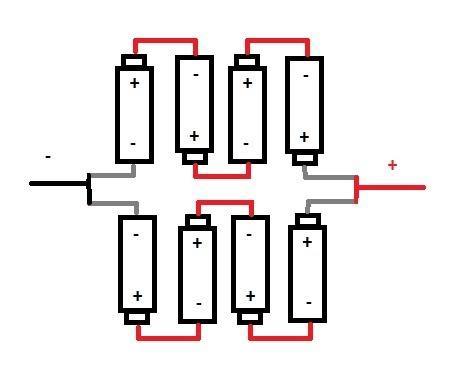
I did however add parallel connections between the cells so at least the voltages between 2 cells in a pair would always be equal. Also added external wires to these to hookup 4 voltmeters.
Before setting out to build you own pack you first should read up on the subject. Numerous sites (google) provide lots of info including warnings always to use a balancer circuit (which I ignored at my own risk.)
23 hours ago, Gammaboy said:They look like A123s - Hobbyking?
Yup, A123 Systems cell type ANR26650M1A in a version with soldering tabs (which reduces the risk of overheating the cell yourself when connecting cells together).
Cheapest source for me was Eblag. (Beware of chinese copies! Also always check feedback on the seller.) Paid 8 euro / cell, so with 64 euro + shipping I reckoned it worth the experiment.
There's a newer more beterer improved type now, ANR26650M1B. These can be identified by the black marks at one end. A bit more expensive too it seems..
Not sure if there is a version with pre-installed soldering tabs of this new type though..
-
VHT do a specific brake caliper paint in various colours. Never used it myself though, but it is said it is good stuff..
-
14 minutes ago, Cobby said:
So would there be any benefits in changing the system at all, not necessarily for a dyna s system but for anything different?
No. If the stock ES ignition is in good working condition there's little reason for replacing it. On tuned high performance bikes it makes sense to run an aftermarket ignition system as these allow easy timing alterations etc. They may also deliver fatter sparks (esp. at higher revs). Useful or even critical on tweaked engines that are pushed to the limit, but not so on stock street bikes already fitted with an electronically controlled ignition system.
-
Old thread, but I'd like to add some comments.
Using LiFePO4 cell packs to replace more traditional lead batteries is a perfectly viable option for street bikes. Although AGM lead batteries are very reliable (especially compared to old wet cell type), weight and size are the obvious benefits of switching to a lithium iron phosphate battery. (NOT: LiPo !)
LiFePO4 cells are especially well suited for short bursts of power like cranking over a big engine. They however have no capacity to "recover" like lead batteries do. So "running it dry" on an engine that refuses to fire up means there's no second chance as all electrical charge has been burnt. Also, more importantly, flattening a LiFePO4 cell will permanently damage it. Dropping below 2.5V (so 10V on a "12V" pack) is a bad thing.
So -like is mentioned before- the charging system on a bike has to be working faultlessly before considering LiFePO4. (Replacing the stock regulator for a mosfet one is solid part of making this happen).
Overcharging is not much of a problem (contrary to LiPo cells). Absolute max. for LiFePO4 is said to be 4.2V /cell (16.8V full pack). So no issue fitted to a bike, but for using a separate battery charger you do need to watch the voltage carefully. Charging like this is rare because the pack has very little self discharge (just leave it alone over winter and it will start the bike in spring no problem), but old style regular chargers can be used. No need for expensive "special" lithium chargers whatsoever, so long as you monitor the voltage yourself. Lead batteries stop accepting charge by themselves, but LiFePO4 cells do NOT and just go on charging until they break. As the charging process happens quite fast you'd better not leave the setup out of sight.
Right.. Apart form low voltage LiFePO4 cannot handle low temperatures either. They won't get damaged though, but the performance drops quite a bit. Not much of a problem for most bikers that will only come out when the sun is shining, but starting a bike on a cold winter morning is a problem. Heating up the cell pack is a way to still get going. (Either by bringing the pack indoor, or running the hi-beam for a while which creates a high current that heats the cells.)
Right.. Long story, not done yet.. Balancers.. Commercial LiFePO4 packs have built in balancers circuits that "should" distribute the voltages evenly across all cells and protect against overcharging and discharging. BUT these are rarely perfect and differ between brands. It is difficult to get any info these when buying a LiFePO4 battery. Reviews and public response are the only way to determine the quality level of the circuit of a certain pack.
When I built my own cell pack the balancer technology was not yet as developed as today, and failures of commercial packs were still frequent, I thought it better to try and make my own circuit. Lack of patience and the urge to ride the new project bike meant I bypassed this bit and just went ahead without a balancer circuit. To keep an eye on the voltages I however fitted 4 led voltmeters. To my surprise the voltages never drifted very far apart, so I just kept the simple setup. Has been running for 3 years now.
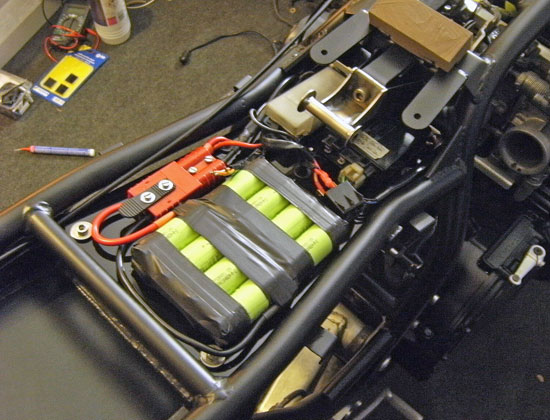
-
 7
7
-
-
Here's an old pic to illustrate the beefier Katana rods.
Front to back:
00A - EFE
493 - Katana
492 - ET/EX/ESD
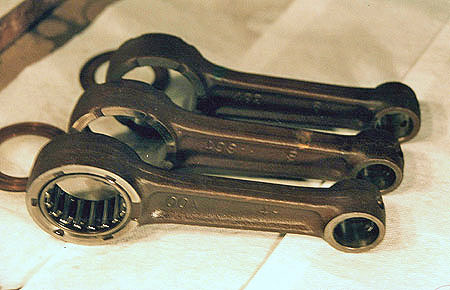
-
 1
1
-
-
The Dyna S system was designed to replace just the breaker points as used on older bikes (like the GS-series). Because the system still makes use of the stock mechanical advancer this Dyna S system does not fit on newer bikes that were never fitted with such a mechanical device on the crank. The advance on those bikes is electronically controlled via a black cdi box somewhere.
In theory it should be possible to fit a mechanical advance unit onto a 750ES and so being able to use a Dyna S thing, but this would be rather a step backwards compared to the technologically more advanced stock ignition system.
-
I've "always" used the same dual K&N filters (RU-2922[set], RU-2920[single]) listed for the oilcooled GSX-R/GSX-F/Bandit on my Mikuni RS36 and 38 carbs. What flatties are you using?
The intake OD on the RS36/38 is a bit smaller though than that of the CVs (55 vs. 60mm IIRC) but the rubber flange on the dual pods can be snugged up small enough to make it fit..
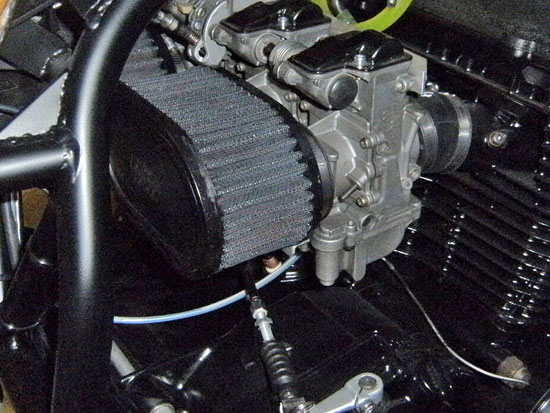
Alternatively you could have a look at the sizes of available dual filters from K&N on this page and perhaps find a better fit.
Some say foam filter pods are "better" than the cotton gauze type though.. (I've never used foam filters myself, so cannot comment on that..)
-
Looks familiar..

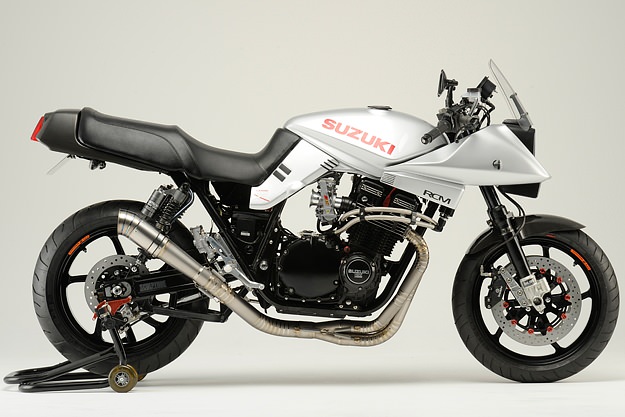
-
 1
1
-
-
12 hours ago, markfoggy said:
Start putting some high speed corners in the mix and you'll soon be starving it.
How do you reckon that? With an on board riding style the forces would be perpendicular to the face of the sump, so the oil would remain in much the same place as if you were going straight (or standing still).. With hanging off though I guess the oil would be slung somewhat to one side (outside corner), but so would the swivelling pickup.. Right? (Of course the swivelling needs to be heavier than the oil, but I think aluminium is..)
Oh.. If oil pickup is a genuine issue on racing engines, why not wire in an ignition cutout linked to the oil pressure sensor as a precaution?
12 hours ago, markfoggy said:Last one that I know went bang in an expensive manner was on a fresh built motor on a dyno, it's officially a dry sump solution ..ish. The motor wasn't level, there was no real acceleration surge and it threw it's rods at max revs.

Dry sump?

Doesn't matter if the motor isn't level as the pickup would swing to the lowest point by gravity, so where the oil would be..
Anyway, the dyno operator should've killed the engine as soon as the oil pressure light came on.. If indeed that was the case.. (Was it?)
The swivelling idea seems quite clever to me, but of course it relies heavily on the swivel-mechanism always functioning correctly.. If would get stuck for some reason (poor manufacturing, debris cought between sliding parts) oil starvation would happen pretty easily..
-
The modified oil pickup (strainer) looks good, and it does improve the issue (pulling air during acceleration), but I just found a nifty solution in use with the 'busa crowd..

It's a swivelling oil pickup! It moves back under acceleration, and swings forwards during braking, so points exactly to where the oil is..

-
 3
3
-
-
23 hours ago, Danm54 said:
I did try it with the tail section on and it just covered the lower frame rails, I wouldn't want them sticking out the bottom.
It just seems a big gap to pack up.
On my Kat-project the rails of the 750ET frame just peeked out below the seat which I didn't like.. So I notched and "kicked up" the ends of these tubes and fabricated a new tail section on the frame as well as the old one didn't fit with the Katana seat at all..
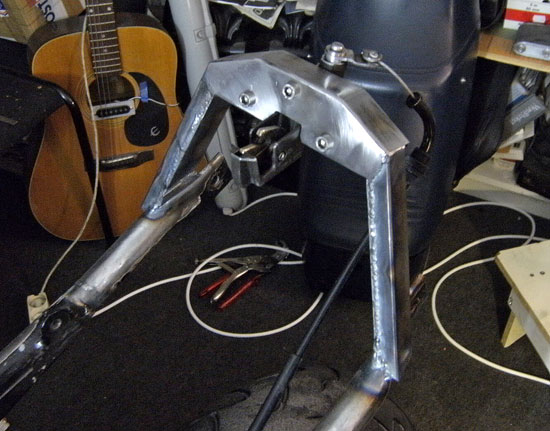
Converted the ET seat latch to cable operation so didn't have an issue with its position not matching the key hole in Katana tail..
Lots of space under the seat for packing tools and whatnot..

Oh.. Modded the taillight as well.. A stock light might not have cleared the latch..
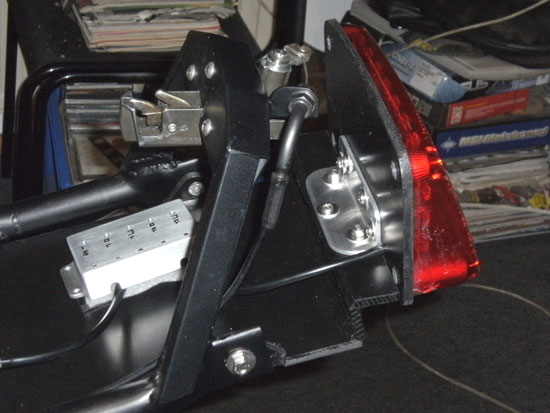
-
 5
5
-
-
On 7-9-2016 at 5:51 PM, Sheep said:
Out of curiosity what thickness metal did you use or is it a case of each bike could vary??
Stainless steel 1,95mm (probably once bought as 2,00mm), but my set of RS's is very worn and also the grooves don't wear evenly over the full length.. So the slack varies at different throttle positions..
-
 1
1
-
-
6 hours ago, Reinhoud said:
I'm not saying they're good or worn! Just reporting the clearances of the bearings on my crank.

Noted, but the chance of all bearings being worn (out) is pretty slim (usually only 1 or 2 go bust).. And also with finding such a small variation, I'd reckon the clearance dimension you found would be pretty typical of bearings on a well used but good crank..
-
 1
1
-
-
On 4-9-2016 at 3:54 AM, Reinhoud said:
Just checked the bearings on the crank I have laying around, they have between 0.01 and 0.02 mm clearance.
Cool.. Nice bit of info..

-
 1
1
-
-
If not fuel, wrong firing order perhaps? Got the caps on the correct plugs? (1-4 and 2-3)
-
 1
1
-
-
Leaking head gasket I reckon.. Look for carbon deposit marks on mating surfaces..
-
14 hours ago, Blubber said:
I would be interested if there is a weight difference between a plastic and a aluminium slide.
Why? They're not CV carbs where a heavier slide would need more air vacuum to lift it..
I'd be interested if there's any difference in dimensions between the aluminium and plastic slides.. (Which would be a real bummer if so..)
-
Cool that it worked out..

With replacing just one plastic slide for an aluminium one you can still expect the remaining slides to also snap/crack at some point in the future though.. (start saving up..
 )
)



starter motor
in Air Cooled
Posted
Yes, odd but true.. The NT (73) on the starter clutch gear of EFE's and earlier is the same.. These gears differ only in ID because of the larger taper on EFE cranks..
Tried to dig up some parts to demonstrate this story, but don't have a spare EFE starter clutch gear lying around.. So just some pics of both idle gear versions..
Btw, I found the EFE gear is about 1.7mm wider than the ET/EX one, so keep this in mind when swapping gears.. (probably leaving one washer/spacer out will do the trick, but do measure before putting the cover back in place..)